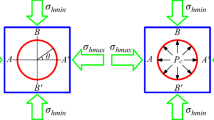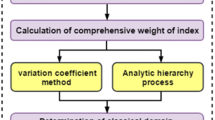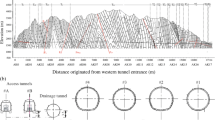Abstract
To evaluate rockbursts in deep-lying long tunnels, a multiple factor analysis and predictions were conducted. It is necessary to establish whether the primary evaluation indexes cover the entire development–occurrence–evolution process for rockbursts and how best to determine the weights of the final selected indexes. We developed an evaluation model with attribute reduction and chose 5 out of 11 primary evaluation indexes to cover the typical characteristics of energy storage, rockburst proneness, and risk of failure. The weights of the primary evaluation indexes and the offset distance were then determined using the entropy weight ideal point method. Combining geostress field inversion and rock mechanic tests, the evaluation model was applied to the case of the Sangzhuling Tunnel along the Sichuan–Tibet railway. Rockburst prediction results achieved 41.2% and 94.1% accuracy when using the Manhattan and Euclidean distance functions, respectively. A more specific classification of the evaluation indexes may optimize the weight assignment and help obtain more accurate results. This paper provides a reliable method for rockburst predictions for hard rock and deep-lying long tunnels, which may have good prospects for engineering applications.










Similar content being viewed by others
Abbreviations
- σ c :
-
Uniaxial compressive strength (UCS) of rock, MPa
- σ t :
-
Tensile strength of rock, MPa
- σ max :
-
Maximum principal stress of the cavern, MPa
- σ θ :
-
Maximum tangential stress of the cavern, MPa
- σ L :
-
Axial stress of tunnel, MPa
- K v :
-
Intactness index of rock mass
- W et . :
-
Elastic energy index
- E s :
-
Maximum elastic strain energy index, kJ/m3
- H :
-
Maximum buried depth of the tunnel, m
- B :
-
Strength brittleness coefficient
- I s :
-
Point load strength of rock, MPa
- RQD :
-
Rock quality designation
- E :
-
Elastic modulus of rock, GPa
- v :
-
Poisson’s ratio
References
Adoko AC, Gokceoglu C, Wu L, Zuo QJ (2013) Knowledge-based and data-driven fuzzy modeling for rockburst prediction. Int J Rock Mech Min Sci 61:86–95
Barton N, Lien R, Lunde J (1974) Engineering classification of rock masses for the design of tunnel support. Rock Mech Rock Eng 6:189–236
Blake W (1972) Rock-burst mechanics. Q J Colorado Sch Min 67:1–64
Cai MF (2016) Prediction and prevention of rockburst in metal mines - a case study of Sanshandao gold mine. J Rock Mech Geotech Eng 8:204–211
Cai M, Kaiser P (2018) Rockburst phenomenon and support characteristics. Laurentian University, Laurentian
Chen NY, Liu Y, Chen HQ, Cheng JJ (2017) Detecting communities in social networks using label propagation with information entropy. Physica A Stat Mech Appl 471:788–798
Chen ZY, Su GS, Woody JJ, Jiang JQ (2019) Experimental study on energy dissipation of fragments during rockburst. Bull Eng Geol Environ 78:5369–5386
China NSCGoPsRo (2014) GB/T 50218-2014 Standard for engineering classification of rock masses. China Planning Press, Beijing
China NSCGotPsRo (2016) TB10003-2016 code for design of railway tunnel. China Railway Publishing House, Beijing
Cook NGW (1965) A note on rockburst considered as a problem of stability. J South Afr Inst Min Metall 65:437–446
Cook NGW, Hoek E, Pretorius JP, Ortlepp WD, Salamon MDG (1966) Rock mechanics applied to study of rockbursts. J South Afr Inst Min Metall 66:435–528
Dietz M, Oremek GM, Groneberg DA, Bendels MHK (2017) Was ist ein Gebirgsschlag? Zentralblatt Für Arbtsmedizin Arbtsschutz Und Ergonomie 68:1–5
Dong LJ, Li XB, Peng K (2013) Prediction of rockburst classification using Random Forest. Trans Nonferrous Metals Soc China 23:472–477
Dorigo M, Blum C (2005) Ant colony optimization theory: a survey. Theor Comput Sci 344:243–278
Feng XT, Wang LN (1994) Rockburst prediction based on neural networks. Trans Nonferrous Metals Soc China 4:7–14
Feng XT, Liu JP, Chen BR, Xiao YX, Feng GL, Zhang FP (2017) Monitoring, warning, and control of rockburst in deep metal mines. Engineering 3:538–545
Feng GL, Feng XT, Chen BR, Xiao YX, Zhao ZN (2019) Effects of structural planes on the microseismicity associated with rockburst development processes in deep tunnels of the Jinping-II Hydropower Station, China. Tunn Undergr Space Technol 84:273–280
Gao F, Zhang Z, Liu X (2012) Research on rock burst proneness index based on energy evolution in rock. Dis Adv 5:1367–1371
He F, Xu XN, Chen R, Zhu LY (2016) Interval efficiency improvement in DEA by using ideal points. Measurement 87:138–145
Hedley DGF (2002) Rockburst handbook for Ontario hardrock mines. CANMET Special Report SP92-1E. Communication Group, Ottawa, Canada
Hoek E, Brown ET (1980) Underground excavations in rock. Institution of Mining and Metallurgy, London
Hudson JA, Feng XT, Brown ET (2015) Rock engineering risk. J Rock Mech Geotech Eng 7:479–480
Jia YP, Lv Q, Shang YQ, Du LL, Zhi MM (2014) Rockburst prediction based on rough set and ideal point method. J Zhejiang Univ 48:498–503
Jia QJ, Wu L, Li B, Chen CH, Peng YX (2019) The comprehensive prediction model of rockburst tendency in tunnel based on optimized unascertained measure theory. Geotech Geol Eng 37:3399–3411
Jiang Q, Feng XT, Xiang TB, Su GS (2010) Rockburst characteristics and numerical simulation based on a new energy index: a case study of a tunnel at 2,500m depth. Bull Eng Geol Environ 69:381–388
Jiang Q, Su GS, Feng XT, Chen GQ, Zhang MZ, Liu C (2019) Excavation optimization and stability analysis for large underground caverns under high geostress: a case study of the chinese laxiwa project. Rock Mech Rock Eng 52:895–915
Jiang Q, Yang B, Yan F, Liu C, Shi YG, Li LF (2020) New method for characterizing the shear damage of natural rock joint based on 3d engraving and 3d scanning. Int J Geomech 20:06019022
Kaiser PK, Cai M (2012) Design of rock support system under rockburst condition. J Rock Mech Geotech Eng 4:215–227
Kaiser PK, Tannant DD, McCreath DR (1996) Canadian rockburst support handbook. Geomechanics Research Centre, Laurentian University, Sudbury
Kidybiński A (1981) Bursting liability indices of coal. Int J Rock Mech Min Sci 18:295–304
Larasati A, Yeh MY (2016) Does more attractive choice always decrease choice deferral? The moderating effect of ideal point. Int J Hosp Manag 54:43–51
Lee SM, Park BS, Lee SW (2004) Analysis of rockbursts that have occurred in a waterway tunnel in Korea. Int J Rock Mech Min Sci 41:545–545
Li N, Feng XD, Jimenez R (2017a) Predicting rock burst hazard with incomplete data using Bayesian networks. Tunn Undergr Space Technol 61:61–70
Li TB, Ma CC, Zhu ML, Meng LB, Chen GQ (2017b) Geomechanical types and mechanical analyses of rockbursts. Eng Geol 222:72–83
Liu ZB, Shao JF, Xu WY, Meng YD (2013) Prediction of rock burst classification using the technique of cloud models with attribution weight. Nat Hazards 68:549–568
Liu F, Ma TH, Tang CA, Chen F (2018) Prediction of rockburst in tunnels at the Jinping II hydropower station using microseismic monitoring technique. Tunn Undergr Space Technol 81:480–493
Ma TH, Tang CA, Tang LX, Zhang WD, Wang L (2015) Rockburst characteristics and microseismic monitoring of deep-buried tunnels for Jinping II Hydropower Station. Tunn Undergr Space Technol 49:345–368
Ma CC, Jiang YP, Li TB (2019) Gravitational Search Algorithm for Microseismic Source Location in Tunneling: Performance Analysis and Engineering Case Study. Rock Mech Rock Eng 52:3999–4016
Meng FZ, Zhou H, Zhang CQ, Xu RC, Lu JJ (2015) Evaluation methodology of brittleness of rock based on post-peak stress–strain curves. Rock Mech Rock Eng 48:1787–1805
Meng FZ, Zhou H, Wang ZQ, Zhang LM, Kong L, Li SJ, Zhang CQ (2016) Experimental study on the prediction of rockburst hazards induced by dynamic structural plane shearing in deeply buried hard rock tunnels. Int J Rock Mech Min Sci 86:210–223
Mitri HS (2007) Assessment of horizontal pillar burst in deep hard rock mines. Int J Risk Assess Manag 7:695–707(613)
Mitri HS, Tang B, Simon R (1999) FE modelling of mining-induced energy release and storage rates. JS Afr Inst Min Metall 99:103–110
Moore GD (1996) Improved Hamiltonian for Minkowski Yang-Mills theory. Nucl Phys 480:689–726
Naji AM, Rehman H, Emad MZ, Yoo H (2018) Impact of shear zone on rockburst in the deep Neelum-Jehlum Hydropower Tunnel: a numerical modeling approach. Energies 11:1935
Ortlepp WD, Stacey TR (1994) Rockburst mechanisms in tunnels and shafts. Tunn Undergr Space Technol 9:59–65
Peixoto A, Sousa LRe, Sousa RLe, Feng X, Miranda T, Martins F Prediction of rockburst based on an accident database. In: Proceedings of the 12th ISRM International Congress on Rock Mechanics, Beijing, 2011. pp 1247–1252
Pu YY, Apel DB, Xu HW (2019) Rockburst prediction in kimberlite with unsupervised learning method and support vector classifier. Tunn Undergr Space Technol 90:12–18
Qiu SL, Feng XT, Zhang CQ, Xiang TB (2014) Estimation of rockburst wall-rock velocity invoked by slab flexure sources in deep tunnels. Can Geotech J 51:520–539
Roohollah SF, Abbas T (2019) Long-term prediction of rockburst hazard in deep underground openings using three robust data mining techniques. Eng Comput 35:659–675
Russenes BF (1974) Analysis of rock spalling for tunnels in steep valley sides. Norwegian Institute of Technology, Department of Geology, Norway
Tarasov BG, Randolph MF (2011) Super brittleness of rocks and earthquake activity. Int J Rock Mech Min Sci 48:888–898
Turchaninov IA (1978) Interrelation between the stressed state of rocks and their properties. Sov Min Sci 14:140–144
Wang QW (2018) Analysis of geostress field and rockburst prediction in the SangZhuling Tunnel of Lhasa-Nyingchi railway engineering. Dissertation, Chengdu Univerrsity of Technology
Wang JA, Park HD (2001) Comprehensive prediction of rockburst based on analysis of strain energy in rocks. Tunn Undergr Space Technol 16:49–57
Wang YH, Li WD, Li QG (1998) Method of fuzzy comprehensive evaluations for rockburst prediction. Chin J Rock Mech Eng 17:15–23
Wang CL, Wu AX, Lu H, Bao TC, Liu XH (2015) Predicting rockburst tendency based on fuzzy matter-element model. Int J Rock Mech Min Sci 75:224–232
Wang XT, Li SC, Xu ZH, Xue YG, Hu J, Li ZQ, Zhang B (2019) An interval fuzzy comprehensive assessment method for rock burst in underground caverns and its engineering application. Bull Eng Geol Environ 78:5161–5176
Wu SC, Wu ZG, Zhang CX (2019) Rock burst prediction probability model based on case analysis. Tunn Undergr Space Technol 93:103069
Xia YJ, Zhou H, Zhang CQ, He SH, Wang P (2019) The evaluation of rock brittleness and its application: a review study. Eur J Environ Civil Eng. https://doi.org/10.1080/19648189.2019.1655485
Xiao YX, Feng XT, Li SJ, Feng GL, Yu YMQ (2016) Rock mass failure mechanisms during the evolution process of rockbursts in tunnels. Int J Rock Mech Min Sci 83:174–181
Xu J, Liu Q, Jiang J, Liu B (2014) Study of rock burst quantitative prediction based on improved entropy coefficient and efficacy coefficient method. Dis Adv 7:70–75
Xu C, Hu CK, Liu XL, Wang SJ (2017) Information entropy in predicting location of observation points for long tunnel. Entropy 19:1–12
Xu C, Liu XL, Wang EZ, Zheng YL, Wang SJ (2018) Rockburst prediction and classification based on the ideal-point method of information theory. Tunn Undergr Space Technol 81:382–390
Xue Y, Gao F, Teng T, Xing Y (2016) Effect of gas pressure on rock burst proneness indexes and energy dissipation of coal samples. Geotech Geol Eng 34:1–12
Xue YG et al (2019) Prediction of rock burst in underground caverns based on rough set and extensible comprehensive evaluation. Bull Eng Geol Environ 78:417–429
Yan J, He C, Wang B, Meng W, Wu FY (2019) Inoculation and characters of rockburst in extra-long and deep-lying tunnels located on Yarlung Zangbo suture. Chin J Rock Mech Eng 38:769–781
Yu HC, Liu HN, Lu XS, Liu HD (2009) Prediction method of rock burst proneness based on rough set and genetic algorithm. J Coal Sci Eng 15:367–373
Zhang M, Huang J, Ju NP, Zhang YL, Zhang GZ (2019) Inverse analysis on in-situ stress field of super-long and deep buried tunnel in Chuan-Zang railway. Chin J Undergr Space Eng 15:1232–1238
Zhao HB, Ru ZL, Chang X, Yin SD, Li SJ (2014) Reliability analysis of tunnel using least square support vector machine. Tunn Undergr Space Technol 41:14–23
Zhou J, Shi XZ, Dong L, Hu HY, Wang HY (2010) Fisher discriminant analysis model and its application for prediction of classification of rockburst in deep-buried long tunnel. J Coal Ence Eng 16:144–149
Zhou H, Meng FZ, Zhang CQ, Hu DW, Lu JJ (2014) Analysis of rockburst mechanisms induced by structural planes in deep tunnels. Bull Eng Geol Environ 74:1–17
Zhou J, Li XB, Mitri HS (2016a) Classification of rockburst in underground projects: Comparison of ten supervised learning methods. J Comput Civ Eng 30:1–19
Zhou KP, Lin Y, Deng HW, Li JL, Liu CJ (2016b) Prediction of rock burst classification using cloud model with entropy weight. Trans Nonferrous Metals Soc China 26:1995–2002
Zhou J, Li XB, Mitri HS (2018) Evaluation method of rockburst: state-of-the-art literature review. Tunn Undergr Space Technol 81:632–659
Zhou XL, Zhang G, Song YH, Hu SH, Liu MZ, Li JZ (2019a) Evaluation of rock burst intensity based on annular grey target decision-making model with variable weight. Arab J Geosci 12:43
Zhou XP, Peng SL, Zhang JZ, Qian QH, Lu RC (2019b) Predictive acoustical behavior of rockburst phenomena in Gaoligongshan tunnel, Dulong river highway, China. Eng Geol 247:117–128
Acknowledgements
The authors thank the editors and the anonymous reviewers for the valuable comments on this study.
Availability of data and material
The data and material used to support the findings of this study are available from the corresponding author upon request.
Funding
The financial support of the National Natural Science Foundation of China (Grant No. 41672295), General Project of the Science and Technology Department in Sichuan province (Grant No.17YYJC0799), Science and Technology Project of Department of Transportation of Sichuan Province (Grant No.2015B1-1), and Scientific project of China Railway Eryuan Engineering Group Co., Ltd. (Grant No. KYY2020122(20-22)) are gratefully acknowledged.
Author information
Authors and Affiliations
Contributions
Shikuo Chen and Hang Zhou contributed to the study conception and design. Hang Zhou performed the simulations and wrote the first draft. Material preparation and data collection were performed by Hang Zhou, Hanrui Li, Tong Liu, and Huanlong Wang. Hang Zhou and Shikuo Chen analyzed the calculation and test data. All authors commented on previous versions of the manuscript. Shikuo Chen revised the paper and gave final approval of the version to be submitted.
Corresponding author
Ethics declarations
Conflict of interest
The authors declare no conflict of interest.
Code availability
The code used to support the findings of this study are available from the corresponding author upon request.
Rights and permissions
About this article
Cite this article
Zhou, H., Chen, S., Li, H. et al. Rockburst prediction for hard rock and deep-lying long tunnels based on the entropy weight ideal point method and geostress field inversion: a case study of the Sangzhuling Tunnel. Bull Eng Geol Environ 80, 3885–3902 (2021). https://doi.org/10.1007/s10064-021-02175-9
Received:
Accepted:
Published:
Issue Date:
DOI: https://doi.org/10.1007/s10064-021-02175-9




